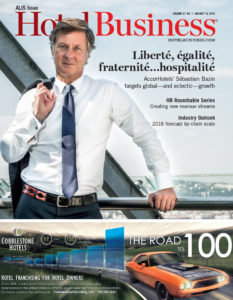Luxury hotels are poised for another year of strong performance, experts say, with gains in occupancy and RevPAR projected to lead all chain scales, along with robust gains in room rate. Favorable supply and demand conditions, as well as the international economy, are expected to be key drivers for luxury hotel performance in 2018.
Sources told Hotel Business that minimal new supply, paired with healthy demand and an ongoing wellspring of overseas visitors, will once again enable luxury hotels to enjoy market-high occupancy levels. These profitable supply and demand trends also allow luxury hotels to continue to grow ADR, further boosting RevPAR.
“With respect to luxury, we’re seeing limited amounts of new supply coming in next year, so holding everything else constant would be helpful in terms of revenue and profit growth in that tier,” said Mark Woodworth, senior managing director of CBRE Hotels’ Americas Research. “Another important factor is the amount of international inbound demand at the market level. We see some cities, like Miami, where I think something like 60-plus percent of the rooms sold have an international component to it. Oftentimes, those travelers will stay in the luxury tier.”
 CBRE is expecting occupancy growth of 1% to 74.4% overall, an average ADR increase of 2.5% to $331.87, and RevPAR growth of 3.5% to $246.95. These projections are the firm’s highest for growth rates in occupancy and RevPAR in 2018; luxury hotels also rank second overall for ADR growth, tied with midscale and just 0.2% behind economy, which is the anticipated ADR growth leader. STR is projecting slightly less expansive numbers for the segment, with a year-end 2018 occupancy decline of -0.1%, ADR growth of 2.3% and a RevPAR increase of 2.2%.
CBRE is expecting occupancy growth of 1% to 74.4% overall, an average ADR increase of 2.5% to $331.87, and RevPAR growth of 3.5% to $246.95. These projections are the firm’s highest for growth rates in occupancy and RevPAR in 2018; luxury hotels also rank second overall for ADR growth, tied with midscale and just 0.2% behind economy, which is the anticipated ADR growth leader. STR is projecting slightly less expansive numbers for the segment, with a year-end 2018 occupancy decline of -0.1%, ADR growth of 2.3% and a RevPAR increase of 2.2%.
“So much of it just goes back to the basics of supply and demand,” said Robert Mandelbaum, director of research information services for CBRE Hotels’ Americas Research. “The luxury segment and the economy segment are the two chain scales projected to experience the least supply growth percentage-wise in 2018. For luxury hotels, in addition to leading in RevPAR growth, we’re forecasting an increase in occupancy and one of the strongest ADR growths as well.”
Some hoteliers are projecting their properties to perform even better than industry estimates. The current strength of the economy, should it continue to perform at present levels, is expected to stimulate increased transient demand. Depending on local market conditions, that may translate into a significantly higher boost than national averages.
“We certainly do expect ADR growth of between 5% and 8% next year, depending on location,” said Paul Wischermann, president & CEO of Wischermann Partners. “When you think about increased leisure travel, that’s more than just people wanting to spend a weekend away from home. They want to do something special. All of that is opportunity for us in a healthy economic environment.”
And while transient demand remains the backbone for the luxury segment—which is the basis for much of the current optimism—some hoteliers say demand is also improving from the group sector. Group bookings may accelerate in 2018, according to sources, pushing the potential for the luxury chain scale still further in the coming year.
“Transient has really been the driving force over the last several years, but several factors are leading to an improving outlook for the group segment,” said Michael Medzigian, chairman and managing partner of Watermark Capital Partners. “Overall group demand has remained steady, and many of our managers have focused on ‘grouping up’ in 2017 and into 2018. We could experience tailwinds in coming periods as the market has traditionally seen a booking lag of approximately four quarters as it relates to changes in corporate profits and changes in business travel. Additionally, corporate tax cuts could help to further stimulate group demand.”
Additionally, international travelers—who tend to gravitate toward U.S. luxury properties—continue to bring their sizeable share of demand. Despite rumors of a “Trump effect” stemming from the current presidential administration’s travel ban, it appears international arrivals remain strong, which bodes well again this year for the luxury segment.
“While the economy has been improving domestically this year, that same phenomenon has been occurring all around the world, and within that, the consumers’ levels of discretionary income has been growing very nicely,” said Woodworth. “As a result, we’re seeing more and more people on a global basis traveling. The U.S. continues to be an attractive destination, and luxury hotels oftentimes are a key beneficiary of that. That’s helping to contribute to why we feel as good as we do about demand and rate growth potential in the luxury tier.”

